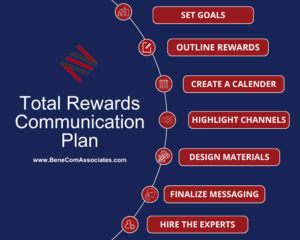Total rewards statements, more commonly referred to as benefit statements, are an important part of HR initiatives. Every company should be leveraging total rewards statements to overview the compensation and benefits package provided to employees, but unfortunately, many organizations miss out on this opportunity to “spotlight hidden value”.
Your total reward strategy is the intentional and documented approach you take to ensure your total rewards program is effective in recruiting, retaining, and engaging prospective and existing employees. Your strategy should not only encompass a competitive compensation program and benefits package, but non-monetary aspects like recognition, growth, wellness, and balance, along with effective communication of these programs and their value.
While most organizations offer a total rewards package in one form or another, many organizations never take the time to draft a strategy. Establishing a plan around employee benefits and communication around these benefits is critical in employee engagement and retention. It also ensures a holistic approach, preventing your focus from shifting too heavily to pay and missing the mark on benefits or work-life balance, for example.
Think about it from this perspective: perhaps your organization, like most, wants to ensure you have a leg to stand on when it comes to talent. In order to do that, you compare your pay grades to market data every year and adjust them accordingly. In the meantime, society has shifted toward a flexible work culture and better mental health benefits – neither of which you offer nor communicate to employees. You’ve noticed increased difficulty with recruitment and retention. While the practice of annual market analysis has kept your wages competitive, the lack of overall strategy and communication has led you to miss trends and fall behind your competitors in other areas. An intentional communication plan in this situation would have allowed the organization to leverage employee feedback to divide dollars between wages and other meaningful benefits.

A total rewards statement sometimes called a total compensation statement or total benefits statement, is a written overview of all those components of total reward we discussed above along with their value. It’s designed to communicate the total value of the rewards employees receive beyond just their base salary, helping them understand their employer’s total investment. It includes a breakdown of both financial or monetary rewards and non-financial or intangible rewards, including:

Although providing a total rewards statement isn’t mandatory for employers, it offers a myriad of benefits to both the employer and its employees.
These valuable statements are useful for both job candidates and current employees and support effective total reward communication. Existing and prospective employees can reference their statement to better understand how much you – their employer – contribute to their individual employment annually and use that information to make decisions about job offers, childcare costs, promotions, and more.
Effective total reward communication can also drive employee engagement by providing employees with a clear and comprehensive view of the value they receive from their employment beyond their salary. Total rewards statements provide a deeper understanding and appreciation of the investment an organization makes in an employee’s overall well-being and professional development. This transparency and recognition of their total rewards foster a sense of value and loyalty, increasing employee satisfaction and engagement. When employees recognize and understand the full extent of their rewards, they are more likely to feel motivated, committed, and connected to their work, resulting in improved productivity, performance, and overall engagement within the organization.
Likewise, engagement drives employee retention. Those who are engaged experience higher employee satisfaction, reducing their intention to leave the company – and reducing your need to find, hire, and train a replacement.
Total reward communications can also demystify complicated pension and retirement plans and contributions, making them easier to understand and therefore more beneficial for employees. Finally, this more holistic approach to benefits communication increases transparency, building trust between employers and employees and making pay and benefits more valued and accessible for your team members.

If strategizing around total rewards is the first step, effectively communicating that total rewards package is step two. Organizations often drop the ball when it comes to benefits communication, negating all the work they’ve done to select and invest in thoughtful and advantageous benefits. If employees don’t know what you’re investing in them, which perks and benefits are available to them, or how to access them, then they don’t benefit from them, and those downstream impacts – like engagement and retention – never come to fruition.
When it comes to communicating benefits to employees, organizations can utilize various channels to effectively convey information, including your intranet or employee portal, benefits guide or handbook, email, presentations, meetings, collaboration tools, one-on-one meetings, mobile apps, and printed materials. It’s important to consider employee preferences when selecting communication channels in order to meet the needs of your unique workforce.
To ensure communication is clear, concise, and effective, consider the following tips:
By employing these tactics, organizations can enhance the clarity, conciseness, and effectiveness of their benefits communication, leading to better employee understanding, engagement, and appreciation of the offered benefits.

Establishing a total rewards communication plan is crucial because it ensures your employees have a clear understanding of all the ‘things’ they receive in exchange for recognition of the contributions they make to your organization. A well-executed communication plan helps employees recognize and appreciate the full range of benefits, compensation, and opportunities available to them, fostering transparency, increasing satisfaction, and strengthening engagement.
When outlining your total rewards communication plan, follow these steps:

Benefits communication specialists have specialized knowledge and expertise in communicating complex benefits information to employees. They have a deep understanding of best practices, industry trends, and strategies to engage and educate employees about their total rewards. Hiring professionals to communicate your value proposition ensures your efforts are well-planned, targeted, and delivered in an engaging way.
Benefits communications specialists also have access to tools and resources to develop effective, personal, and simple communication materials that are visually appealing for your employees. They can help with:
Too long to read? Here’s the bottom line: Total rewards offerings refer to all the “things” an employee receives, tangible and intangible, for their contributions to the workplace, and total rewards statements sum up and give value to that package in a single place.
Intrigued by the thought of handing benefits communication off to an expert? BeneCom promises to deliver your visually appealing, easy-to-understand benefits communications on time, on budget, and on message every time. Get started with BeneCom today!